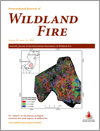International Journal of Wildland Fire
Volume 29
Number 12 2020
This paper explores historical patterns and trends in simultaneous fire in the United States using satellite data and discusses their implications for firefighting. We show that changes in regional simultaneity over the 1984–2015 record may explain historical firefighting resource demand trends and develop models of simultaneous wildfire activity based on dryness and lightning indicators.
In regions that receive both winter and summer rain, wildland fire regimes are coregulated by the climate of both seasons. We studied fire occurrence in mountains of the US–Mexico borderlands using fire-scarred trees and tree-ring-reconstructed climate over multiple centuries. The region exhibits a distinctive ‘monsoon fire regime’ shaped by seasonal and interannual climate variation.
We modelled the relationship between fire occurrence and different spatial factors across Indonesia. We found that fires were associated with human-disturbed land covers, suggesting that most fires in Indonesia originated from human activities. Fires were also associated with drier, hotter weather ranking higher on the fire weather index.
Using lidar-derived three-dimensional maps of canopy bulk density, we demonstrated that repeated prescribed fire does not replicate the structure of landscapes affected by wildfire in the New Jersey Pinelands. Prescribed fires are associated with reduced ladder fuels and increased canopy fuels, whereas wildfires are associated with the opposite pattern.
Litter fuel peaks in the late dry season, whereas cured grassy fuels typically are seasonally invariant, and CWD inputs are associated with stochastic severe wet season storms and fires. The study highlights the need to develop seasonally dynamic modelling approaches that better account for significant seasonal variation in fine fuel inputs.
Fire cues, warnings from a trusted source and prior awareness of fire risks were highly associated with risk perceptions, and risk perception was the variable most influential on evacuation decision. This research also highlights the importance of question comprehension, standardised survey instruments and online sampling methods (for displaced populations).
Sutherland et al. (2020) used numerical modelling simulations to critique the experimental fire methods used by Cruz et al. (2015). We show through the analysis of real-world data from different experimental fire datasets that measurements conducted by Cruz et al. (2015) were in fires spreading in the pseudo-steady-state regime.
We respond to the comments of Cruz et al. (2020) on ‘The effect of ignition protocol on the spread rate of grass fires’. The aim of our paper was to investigate ignition and fire development, not to criticise Cruz et al. (2015). Where comparable, our simulations are in broad agreement with experiments.
This commentary focuses on the Mediterranean heathland or herriza to illustrate how most negative impacts allegedly attributed to wildfires, namely soil erosion and biodiversity loss, actually occur in afforested heathland patches. I advocate for incorporating the large existing body of scientific knowledge on the relationships of Mediterranean ecosystems with fire into plans and policies dealing with wildfire and conservation.





